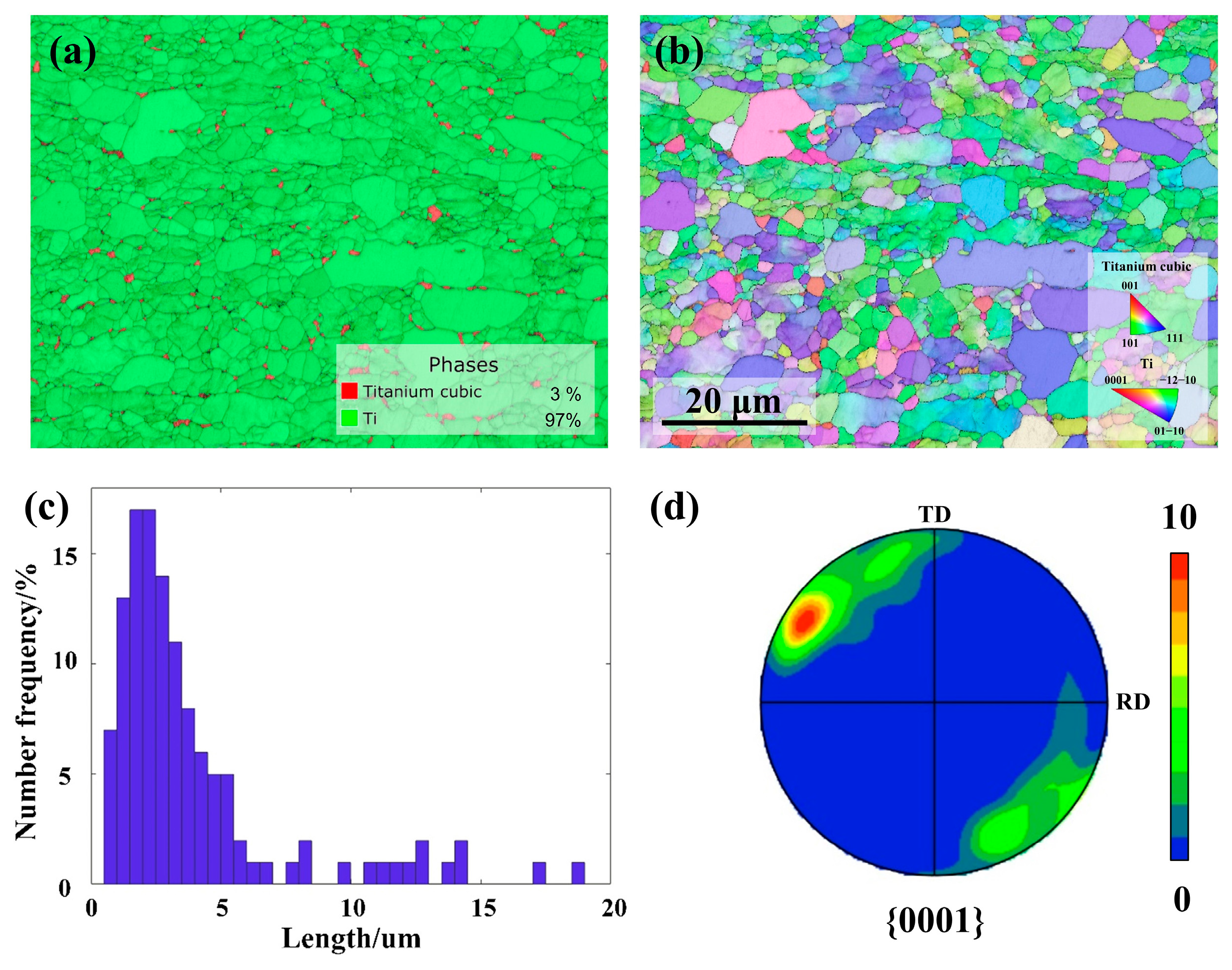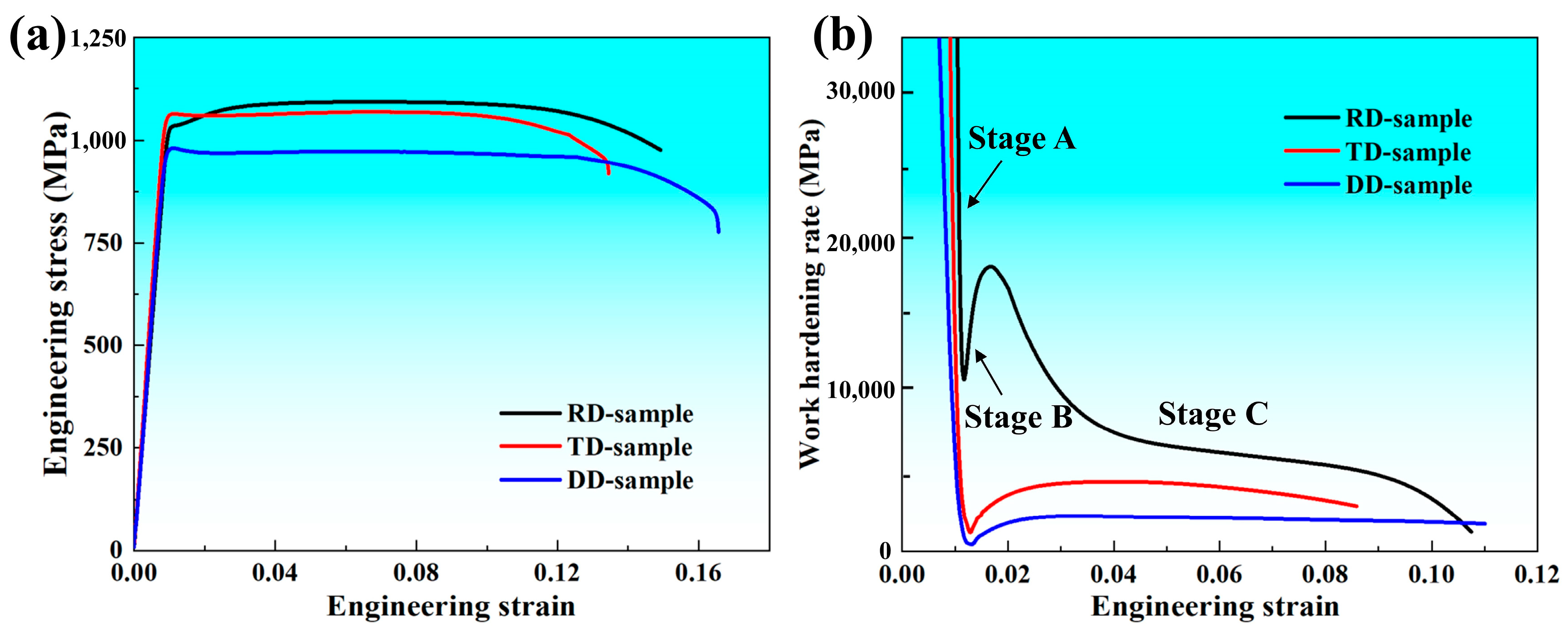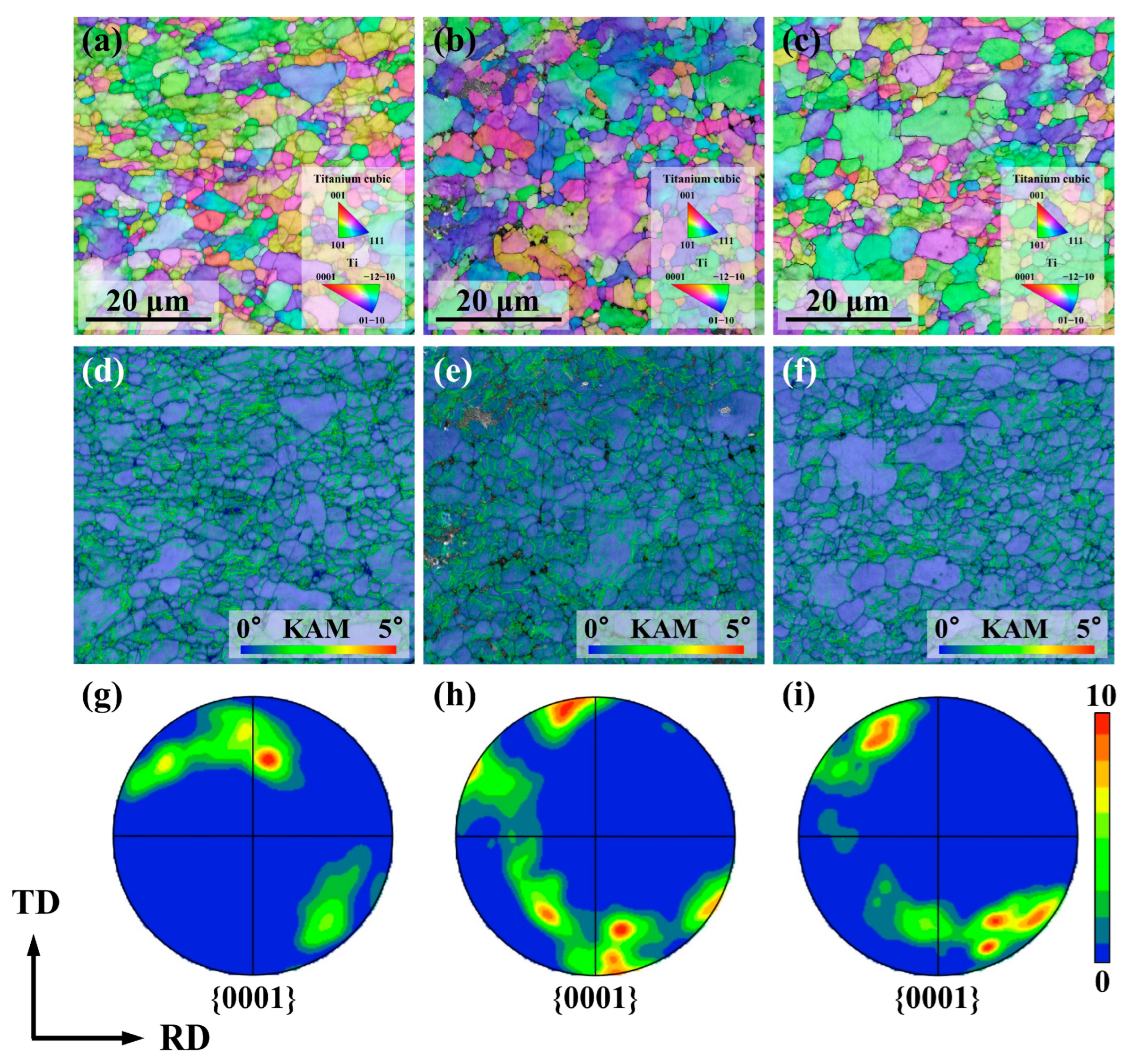Investigation on Anisotropic Mechanical Behavior of Ti-6Al-4V Alloy via Schmid Factor and Kernel Average Misorientation Distribution
Abstract
:1. Introduction
2. Material and Experiments
2.1. Material
2.2. Mechanical Tests
2.3. Microstructure Characterization
3. Results and Discussion
3.1. Initial Microstructure
3.2. Mechanical Behavior
3.3. Microstructure Evolution and Deformation Mechanism
4. Conclusions
Author Contributions
Funding
Institutional Review Board Statement
Informed Consent Statement
Data Availability Statement
Conflicts of Interest
References
- Sun, Q.Y.; Gu, H.C. Tensile and low-cycle fatigue behavior of commercially pure titanium and Ti-5Al-2.5Sn alloy at 293 and 77 K. Mater. Sci. Eng. A 2001, 316, 80–86. [Google Scholar] [CrossRef]
- Ahmed, A.A.; Mhaede, M.; Wollmann, M.; Wagner, L. Effect of micro shot peening on the mechanical properties and corrosion behavior of two microstructure Ti-6Al-4V alloy. Appl. Surf. Sci. 2016, 363, 50–58. [Google Scholar] [CrossRef]
- Ye, X.; Yang, Y.; Song, G.; Tang, G. Enhancement of ductility, weakening of anisotropy behavior and local recrystallization in cold-rolled Ti-6Al-4V alloy strips by high-density electropulsing treatment. Appl. Phys. A 2014, 117, 2251–2264. [Google Scholar] [CrossRef]
- Zhou, J.Z.; Huang, S.; Zuo, L.D.; Meng, X.K.; Sheng, J.; Tian, Q.; Han, Y.H.; Zhu, W.L. Effects of laser peening on residual stresses and fatigue crack growth properties of Ti-6Al-4V titanium alloy. Opt. Lasers Eng. 2014, 52, 189–194. [Google Scholar] [CrossRef]
- Yuan, S.; Fan, X. Developments and perspectives on the precision forming processes for ultra-large size integrated components. Int. J. Extreme Manuf. 2019, 1, 022002. [Google Scholar] [CrossRef]
- Gao, S.; He, T.; Li, Q.; Sun, Y.; Sang, Y.; Wu, Y.; Ying, L. Anisotropic behavior and mechanical properties of Ti-6Al-4V alloy in high temperature deformation. J. Mater. Sci. 2022, 57, 651–670. [Google Scholar] [CrossRef]
- Salem, A.; Semiatin, S. Anisotropy of the hot plastic deformation of Ti-6Al-4V single-colony samples. Mater. Sci. Eng. A 2009, 508, 114–120. [Google Scholar] [CrossRef]
- Roth, A.; Lebyodkin, M.A.; Lebedkina, T.A.; Lecomte, J.S.; Richeton, T.; Amouzou, K.E.K. Mechanisms of anisotropy of mechanical properties of α-titanium in tension conditions. Mater. Sci. Eng. A 2014, 596, 236–243. [Google Scholar] [CrossRef]
- Srinivasan, N.; Velmurugan, R.; Singh, S.K.; Pant, B.; Kumar, R. Texture strengthening and anisotropic hardening of mill annealed Ti-6Al-4V alloy under equi-biaxial tension. Mater. Char. 2020, 164, 110349. [Google Scholar] [CrossRef]
- Chen, W.; Boehlert, C.J. Texture induced anisotropy in extruded Ti-6Al-4V-xB alloys. Mater. Char. 2011, 62, 333–339. [Google Scholar] [CrossRef]
- Song, J.H.; Hong, K.J.; Ha, T.K.; Jeong, H.T. The effect of hot rolling condition on the anisotropy of mechanical properties in Ti-6Al-4V alloy. Mater. Sci. Eng. A 2007, 449, 144–148. [Google Scholar] [CrossRef]
- Sheikh-Ali, A. On flow stress anisotropy in Ti-6Al-4V alloy sheet during superplastic deformation. J. Mater. Sci. 2007, 42, 3621–3626. [Google Scholar] [CrossRef]
- Battaini, M.; Pereloma, E.; Davies, C.H.J. Orientation effect on mechanical properties of commercially pure titanium at room temperature. Metall. Mater. Trans. A 2007, 38, 276–285. [Google Scholar] [CrossRef] [Green Version]
- Srinivasan, N.; Velmurugan, R.; Kumar, R.; Singh, S.K.; Pant, B. Deformation behavior of commercially pure (CP) titanium under equi-biaxial tension. Mater. Sci. Eng. A 2016, 674, 540–551. [Google Scholar] [CrossRef]
- Yi, N.; Hama, T.; Kobuki, A.; Fujimoto, H.; Takuda, H. Anisotropic deformation behavior under various strain paths in commercially pure titanium Grade 1 and Grade 2 sheets. Mater. Sci. Eng. A 2016, 655, 70–85. [Google Scholar] [CrossRef] [Green Version]
- Warwick, J.L.W.; Jones, N.G.; Rahman, K.M.; Dye, D. Lattice strain evolution during tensile and compressive loading of CP Ti. Acta Mater. 2012, 60, 6720–6731. [Google Scholar] [CrossRef]
- Cizek, P.; Kada, S.R.; Wang, J.; Armstrong, N.; Antoniou, R.A.; Lynch, P.A. Dislocation structures representing individual slip systems within the α phase of a Ti-6Al-4V alloy deformed in tension. Mater. Sci. Eng. A 2020, 797, 140225. [Google Scholar] [CrossRef]
- Conrad, H. Effect of interstitial solutes on the strength and ductility of titanium. Prog. Mater. Sci. 1981, 26, 123–403. [Google Scholar] [CrossRef]
- Orozco-Caballero, A.; Li, F.; Esque-De Los Ojos, D.; Atkinson, M.D.; da Fonseca, J.Q. On the ductility of alpha titanium: The effect of temperature and deformation mode. Acta Mater. 2018, 149, 1–10. [Google Scholar] [CrossRef] [Green Version]
- Mayeur, J.R.; McDowell, D.L. A three-dimensional crystal plasticity model for duplex Ti-6Al-4V. Int. J. Plast. 2007, 23, 1457–1485. [Google Scholar] [CrossRef]
- Bantounas, I.; Dye, D.; Lindley, T.C. The effect of grain orientation on fracture morphology during high-cycle fatigue of Ti-6Al-4V. Acta Mater. 2009, 57, 3584–3595. [Google Scholar] [CrossRef] [Green Version]
- Meng, J.K.; Liu, L.; Jiang, J.T.; Huang, G.; Zhen, L. Fracture behaviors of commercially pure titanium under biaxial tension: Experiment and modeling. J. Mater. Sci. Technol. 2023, 140, 176–186. [Google Scholar] [CrossRef]
- Wang, L.; Zheng, Z.; Phukan, H.; Kenesei, P.; Park, J.S.; Lind, J.; Suter, R.M.; Bieler, T.R. Direct measurement of critical resolved shear stress of prismatic and basal slip in polycrystalline Ti using high energy X-ray diffraction microscopy. Acta Mater. 2017, 132, 598–610. [Google Scholar] [CrossRef]
- Zaefferer, S. A study of active deformation systems in titanium alloys: Dependence on alloy composition and correlation with deformation texture. Mater. Sci. Eng. A 2003, 344, 20–30. [Google Scholar] [CrossRef]
- Littlewood, P.D.; Britton, T.B.; Wilkinson, A.J. Geometrically necessary dislocation density distributions in Ti-6Al-4V deformed in tension. Acta Mater. 2011, 59, 6489–6500. [Google Scholar] [CrossRef]
- Barkia, B.; Doquet, V.; Couzinie, J.P.; Guillot, I.; Heripre, E. In situ monitoring of the deformation mechanisms in titanium with different oxygen contents. Mater. Sci. Eng. A 2015, 636, 91–102. [Google Scholar] [CrossRef]
- Zhou, P.; Liang, Z.Y.; Liu, R.D.; Huang, M.X. Evolution of dislocations and twins in a strong and ductile nanotwinned steel. Acta Mater. 2016, 111, 96–107. [Google Scholar] [CrossRef]
- Liang, Z.Y.; Li, Y.Z.; Huang, M.X. The respective hardening contributions of dislocations and twins to the flow stress of a twinning-induced plasticity steel. Scripta Mater. 2016, 112, 28–31. [Google Scholar] [CrossRef]
- Zhao, P.C.; Yuan, G.J.; Wang, R.Z.; Guan, B.; Jia, Y.F.; Zhang, X.C.; Tu, S.T. Grain-refining and strengthening mechanisms of bulk ultrafine grained CP-Ti processed by L-ECAP and MDF. J. Mater. Sci. Technol. 2021, 83, 196–207. [Google Scholar] [CrossRef]
- Benjamin Britton, T.; Wilkinson, A.J. Stress fields and geometrically necessary dislocation density distributions near the head of a blocked slip band. Acta Mater. 2012, 60, 5773–5782. [Google Scholar] [CrossRef]
- Gao, J.; Huang, Y.; Guan, D.; Knowles, A.J.; Ma, L.; Dye, D.; Rainforth, W.M. Deformation mechanisms in a metastable beta titanium twinning induced plasticity alloy with high yield strength and high strain hardening rate. Acta Mater. 2018, 152, 301–314. [Google Scholar] [CrossRef]
- Fattah-alhosseini, A.; Keshavarz, M.K.; Mazaheri, Y.; Reza Ansari, A.; Karimi, M. Strengthening mechanisms of nano-grained commercial pure titanium processed by accumulative roll bonding. Mater. Sci. Eng. A 2017, 693, 164–169. [Google Scholar] [CrossRef]
- Jiang, Y.; Li, C.; Di, X.; Wang, D.; Liu, J. EBSD analysis of microstructures and mechanical properties of softened zones in X60 reeled-pipeline welded joint after cyclic plastic deformation. Weld. World 2020, 64, 1213–1225. [Google Scholar] [CrossRef]
- Moshtaghi, M.; Safyari, M.; Kuramoto, S.; Hojo, T. Unraveling the effect of dislocations and deformation-induced boundaries on environmental hydrogen embrittlement behavior of a cold-rolled Al-Zn-Mg-Cu alloy. Int. J. Hydrogen Energy 2021, 46, 8285–8299. [Google Scholar] [CrossRef]






| Elements | Al | V | Fe | H | O | Ti |
|---|---|---|---|---|---|---|
| Analyzed composition | 6.18 | 4.16 | 0.12 | 0.01 | 0.12 | Bal. |
| Tensile Direction | |||
|---|---|---|---|
| RD | 1030 | 1090 | 0.149 |
| TD | 1060 | 1069 | 0.133 |
| DD | 960 | 980 | 0.165 |
Disclaimer/Publisher’s Note: The statements, opinions and data contained in all publications are solely those of the individual author(s) and contributor(s) and not of MDPI and/or the editor(s). MDPI and/or the editor(s) disclaim responsibility for any injury to people or property resulting from any ideas, methods, instructions or products referred to in the content. |
© 2022 by the authors. Licensee MDPI, Basel, Switzerland. This article is an open access article distributed under the terms and conditions of the Creative Commons Attribution (CC BY) license (https://creativecommons.org/licenses/by/4.0/).
Share and Cite
Meng, J.; Chen, X.; Jiang, J.; Liu, L. Investigation on Anisotropic Mechanical Behavior of Ti-6Al-4V Alloy via Schmid Factor and Kernel Average Misorientation Distribution. Metals 2023, 13, 89. https://doi.org/10.3390/met13010089
Meng J, Chen X, Jiang J, Liu L. Investigation on Anisotropic Mechanical Behavior of Ti-6Al-4V Alloy via Schmid Factor and Kernel Average Misorientation Distribution. Metals. 2023; 13(1):89. https://doi.org/10.3390/met13010089
Chicago/Turabian StyleMeng, Jinkui, Xiangguang Chen, Jiantang Jiang, and Li Liu. 2023. "Investigation on Anisotropic Mechanical Behavior of Ti-6Al-4V Alloy via Schmid Factor and Kernel Average Misorientation Distribution" Metals 13, no. 1: 89. https://doi.org/10.3390/met13010089





